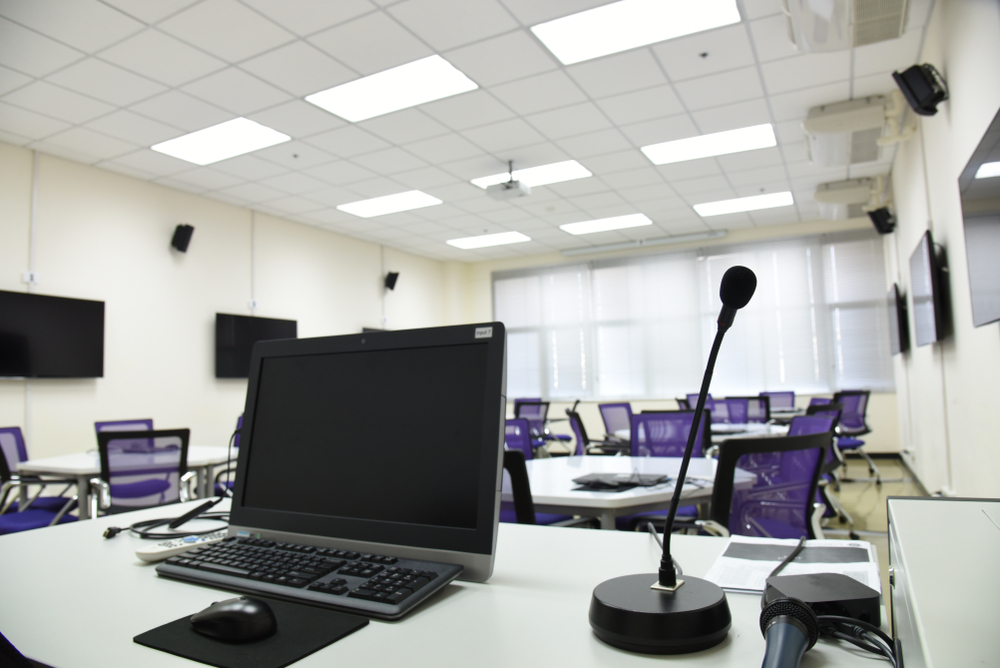Integrating technology into teaching practices has become important in the changing landscape of education. Among the most impactful advancements are audiovisual (AV) teaching aids, which have revolutionised how educators deliver content and engage with students. These tools offer a dynamic and interactive approach to learning, enhancing students’ understanding, retention, and overall academic performance. This article delves into the numerous benefits of using audiovisual aids in schools, illustrating why they are indispensable in modern education.
1. Enhancing Student Engagement
One of the most significant advantages of using audio-visual aids in the classroom is their ability to captivate students’ attention. Traditional teaching methods, which rely heavily on verbal instruction and textbooks, can often struggle to keep students engaged, particularly in today’s digital age. Audio-visual aids, such as videos, interactive whiteboards, and digital presentations, bring lessons to life, making them more exciting and relatable.
For instance, a geography lesson on volcanoes can be transformed by showing a video of an eruption, giving students a real-world context that is far more engaging than reading about it in a textbook. This multi-sensory approach caters to different learning styles, ensuring that visual, auditory, and kinesthetic learners are all accommodated.
2. Improving Comprehension and Retention
Research has consistently shown that students retain information better when presented through multiple channels. Audio-visual aids combine sight and sound to reinforce learning, helping students to understand and remember complex concepts more effectively. For example, using a diagram alongside an explanation can help students visualise the information, making it easier to recall later.
Moreover, videos and animations can simplify difficult topics by breaking them down into manageable parts. A science teacher explaining the process of photosynthesis, for instance, might use an animated video to demonstrate each step visually, making the concept clearer and more memorable for students.
3. Supporting Inclusive Learning
One of the key benefits of audio visual aids is their ability to support inclusive learning environments. Students with different needs, such as those with learning difficulties or those who speak English as an additional language, can benefit enormously from the use of AV tools. Visual aids can provide additional context to spoken words, making it easier for these students to follow along.
In addition, subtitles on videos and the ability to replay audio content can help students who might need more time to process information. By offering multiple ways to access and engage with the material, AV aids help to ensure that all students, regardless of their abilities or backgrounds, can participate fully in the learning process.
4. Facilitating Active Learning
Active learning is an educational approach that emphasises student participation and engagement in the learning process. Audio visual aids are particularly effective in promoting active learning by encouraging students to interact with the material. Tools such as interactive whiteboards allow students to engage directly with the content, whether by answering questions, solving problems, or contributing ideas in real time.
Additionally, the use of multimedia projects, where students create their own videos or presentations, fosters creativity and critical thinking. These activities not only make learning more enjoyable but also help students develop important skills such as collaboration, communication, and problem-solving.
5. Bridging the Gap Between Theory and Practice
One of the challenges in education is helping students connect theoretical knowledge with real-world applications. Audio visual aids can bridge this gap by providing concrete examples of abstract concepts. For example, a maths lesson on geometry can be enhanced by using 3D modelling software to show how geometric shapes are used in architecture and engineering.
Furthermore, AV aids can bring global perspectives into the classroom. A history teacher might use documentary footage to give students a glimpse into life during a particular historical period, helping them to understand the human impact of historical events. By making learning more relevant to students’ lives and the world around them, AV tools foster a deeper understanding and appreciation of the subject matter.
6. Increasing Teacher Efficiency
Audio visual aids do not only benefit students; they also enhance teacher efficiency. By incorporating AV tools into their lessons, teachers can deliver content more effectively and efficiently. For example, pre-recorded videos can be used to explain complex concepts, freeing up class time for discussion and application. Interactive presentations can also help teachers assess students’ understanding in real time, allowing them to adjust their teaching strategies as needed.
Additionally, AV tools can reduce the preparation time for lessons. Teachers can use ready-made resources such as educational videos, online simulations, and digital textbooks, rather than having to create all materials from scratch. This not only saves time but also ensures that teachers have access to high-quality, up-to-date content.
7. Preparing Students for the Future
In a world that is increasingly driven by technology, it is essential that students are equipped with the skills they need to succeed in the future. The use of audio visual aids in the classroom helps students become familiar with digital tools and technologies, preparing them for the demands of higher education and the modern workplace.
By engaging with AV tools, students learn how to navigate and utilise digital resources, develop critical media literacy skills, and become more adept at using technology for problem-solving and communication. These skills are invaluable in today’s job market, where digital competence is often a prerequisite.
Conclusion: The Indispensable Role of Audio Visual Aids in Education
The benefits of audio visual teaching aids in schools are vast and varied, making them an indispensable part of modern education. From enhancing student engagement and improving retention to supporting inclusive learning and preparing students for the future, AV tools offer a comprehensive solution to many of the challenges faced by educators today.
For schools looking to invest in high-quality audio visual equipment, KPMS offers a wide range of products designed to meet the needs of today’s classrooms. By integrating these tools into your teaching practices, you can create a more dynamic, engaging, and effective learning environment that supports the success of all students.



